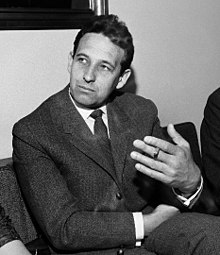Ashes and Diamonds (film)
Ashes and Diamonds, although based on the novel that directly supported the postwar Communist system in Poland, was subtly modified in comparison with the source material.
On 8 May 1945, at the end of World War II, near a small country church, former Home Army soldiers Maciek, Andrzej and Drewnowski prepare to assassinate Konrad Szczuka, a political opponent and a secretary of Polish Workers' Party.
While sitting in the bar, Maciek and Andrzej listen to the song "The Red Poppies of Monte Cassino" and reminisce over their fallen comrades.
Their hapless comrade Drewnowski gets drunk at the bar, where he discusses career prospects in postwar Poland with Pieniążek, a representative of the democratic press.
Meanwhile, a completely drunk Drewnowski spoils the banquet, covering the other guests with foam from a fire extinguisher, and leaves the ball in shame with his intended career as a Communist functionary in ruins.
Historian Tadeusz Lubelski retrospectively commented on Axer's script with the following words: "Communists are even more decent and busy, aristocrats and former Home Army members – even more vile and reckless.
"[10] Jan Rybkowski also planned to direct an Ashes and Diamonds adaptation, though he eventually decided to focus on a comedy titled Kapelusz pana Anatola (Mr. Anatol's Hat).
However, he finally chose an atelier in Wrocław, the decision made due to possible savings and to prevent the policymakers from intervening too much in the film development.
On 3 February 1958, the acting Chief of Cinematography Jerzy Lewiński decided to start the production of Ashes and Diamonds, without consulting the authorities.
Stanisław Adler became the producer, whereas Jerzy Wójcik took the cinematography, and Filip Nowak was commissioned to select music material for the film.
Morgenstern, more familiar with the acting market, encouraged Wajda to put Zbigniew Cybulski in the role of Maciek, although the director considered the candidature of Tadeusz Janczar.
[18] Having come to the film set, Cybulski instantly refused to play in a partisan uniform suggested by costume designer Katarzyna Chodorowicz, and insisted on wearing his "fifties' style dark glasses, jacket and tight jeans.
[24] The ending was changed, too; Wajda cut down the scene from the novel, during which some soldiers of Polish People's Army commented on Maciek's death with following words: "Hey, you, ... what made you run away?
It was then that Andrzejewski himself, who–with the support of his fellow writers–convinced PZPR activists that the ideological message of the film was correct; without the help of the author of the novel, Wajda's work would have never been released.
[28] Nevertheless, due to the still existing doubts about its message, Ashes and Diamonds were banned from taking part in the main competition of the Cannes Film Festival.
[31] Cybulski has been compared to James Dean in his performance, which was complemented by the fact that with his appearance, Polish actor personified the contemporary generation of the 1950s.
The tragic actions of Home Army soldiers, who supposedly unjustly continued their struggle against the new political reality, were pointed out at that time.
"[35] Marxist reviewers criticized Ashes and Diamonds, highlighting its alleged lack of educational functions and the marginalization of Szczuka, who was depicted in the film as a mediocre party activist.
Alicja Helman, in turn, put forward the opinion that "there is everything in this film–too much, too good, too beautiful", but at the same time it emphasizes "zeal, anxiety, takeover, great emotional passion".
[36] Ernest Bryll devoted a broader analysis to the evaluation of the antique structure of film work, with an inseparable fate showing the tragedy of the main character's actions.
[39] Krzysztof Kąkolewski deplored the fact that Wajda's Ashes and Diamonds for Polish and international audiences were for years a source of knowledge about the times after the Second World War.
[40] Conversely, Tadeusz Lubelski stated that Wajda's version warms the image of the underground to a much greater extent than the ones proposed by Axer and Bohdziewicz.
[42] Dave Kehr from Chicago Reader shared an opinion that "[f]ollowing the art cinema technique of the time, Wajda tends toward harsh and overstated imagery,"[44] while the Time Out London review stated that "Wajda's way is the sweet smell of excess, but some scenes remain powerfully memorable – the lighting of drinks on the bar, the upturned Christ in a bombed church, and Cybulski's prolonged death agonies at the close.
"[45] As David Parkinson from Empire said, "[Wajda's] final installment of the classic Polish trilogy is heavy in symbolism but remains affective and intimate viewing.
[52] Directors Martin Scorsese, Hayao Miyazaki, Francis Ford Coppola, Paweł Pawlikowski and Roy Andersson have listed it as one of their favourite films of all time.
[57] Ashes and Diamonds had a significant impact on the development of the Polish Film School, causing a polemical reaction from other directors of the movement.
Unlike Maciek Chełmicki, the protagonist of this film–also a soldier of the independence underground–does not carry out the order, but tries to start life anew and settle in the Recovered Territories.
[61] However, while conservative circles regarded Wajda's The Crowned-Eagle Ring as a fair settlement of accounts with the past period,[62] the film aroused embarrassment among liberal critics, with Jakub Majmurek writing about "the most painful aesthetic self-disgrace" on the part of the director.
[65] After watching the film Ashes and Diamonds for several times at Oslo in 1960, theatre director Eugenio Barba decided to go to Poland for his further studies in directing.
[66] In a 2024 interview with Letterboxd, Martin Scorsese and Leonardo DiCaprio cited Ashes and Diamonds as one of their core inspirations for the 2006 Academy-Award winning film The Departed.

